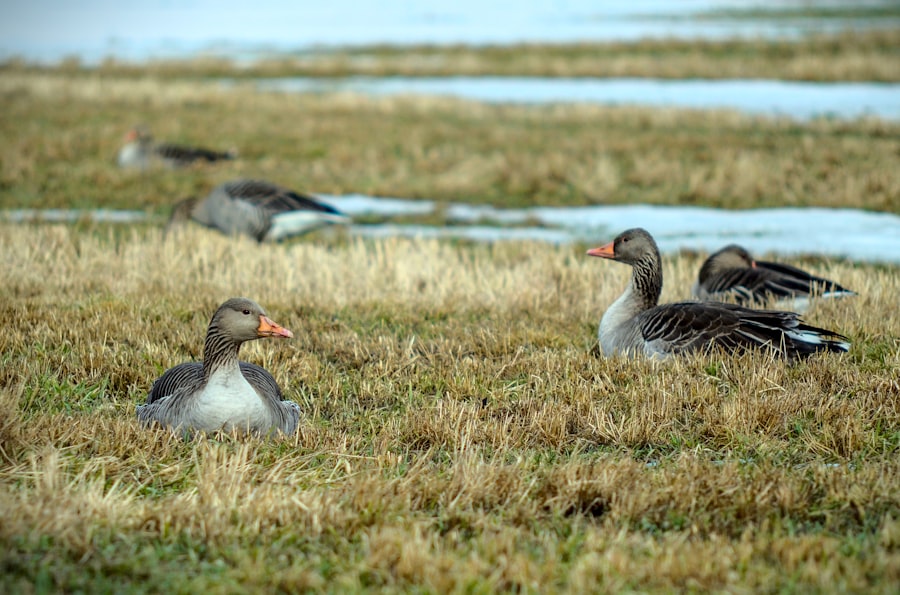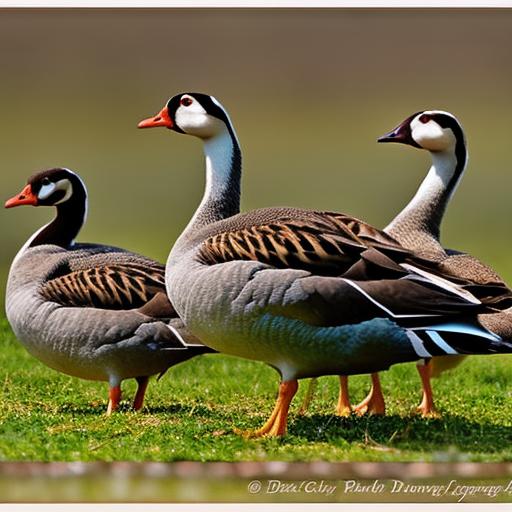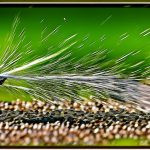Keeping geese can be a rewarding and fulfilling hobby, as well as a profitable venture for those interested in poultry production. Geese are known for their beauty, intelligence, and social nature, making them a popular choice among poultry enthusiasts. Whether you are interested in keeping geese for their eggs, meat, or simply as pets, there are many benefits to be gained from having these fascinating birds in your flock.
One of the main benefits of keeping geese is their ability to control pests. Geese are natural grazers and will happily munch on grass, weeds, and insects, helping to keep your lawn or pasture free from unwanted pests. They are also excellent watch animals and will alert you to any potential threats or intruders with their loud honking. Additionally, geese can provide a sustainable source of food through their eggs and meat, making them a valuable addition to any homestead or small farm.
Key Takeaways
- Keeping geese can be a rewarding experience for those interested in raising poultry.
- Geese are social animals that require companionship and a male goose is important for breeding purposes.
- The number of female geese to keep with a male depends on the size of the enclosure and available space.
- Feeding requirements and resources should be considered when managing a flock of geese.
- It is important to manage aggression and territorial behavior to ensure the health and well-being of the geese in the flock.
Understanding the social behavior of geese
Geese are highly social animals that thrive in the company of others. They form strong bonds with their flock mates and rely on each other for protection and companionship. Within a flock, there is a clear hierarchy and pecking order that determines the social structure. This hierarchy is established through displays of dominance and aggression, such as hissing, neck stretching, and wing flapping.
Communication among geese is primarily done through vocalizations and body language. Geese have a wide range of vocalizations that they use to communicate with each other, including honking, hissing, and grunting. They also use body language, such as head bobbing and wing flapping, to convey messages to other members of the flock.
Importance of having a male goose in the flock
Having a male goose in the flock is essential for breeding purposes. The male goose, also known as a gander, plays a crucial role in the reproduction process. During the breeding season, the gander will court the female geese, performing elaborate displays to attract their attention. Once a pair has formed, the gander will mate with the female and fertilize her eggs.
In addition to breeding, having a male goose in the flock can provide other benefits. Male geese are known for their protective nature and will fiercely defend their flock against predators. They are also excellent watch animals and will alert the flock to any potential threats or dangers. Furthermore, male geese can help maintain order within the flock by establishing and enforcing the pecking order.
Factors to consider when determining the number of female geese to keep with a male
When determining the number of female geese to keep with a male, there are several factors to consider. The male to female ratio is an important consideration, as having too many females per male can lead to aggression and fighting within the flock. A general rule of thumb is to have one male for every three to five females.
The age and maturity of the geese should also be taken into account. Younger geese may not be ready for breeding, so it is important to wait until they have reached sexual maturity before introducing them to a male. Additionally, older geese may have a decreased fertility rate, so it is important to consider their age when determining the number of females to keep with a male.
Available space and resources are also important factors to consider. Geese require ample space to roam and graze, so it is important to provide enough room for them to move around comfortably. Additionally, having enough food and water resources is crucial for maintaining a healthy and happy flock.
Size of the enclosure and available space
Geese require a minimum amount of space in order to thrive and exhibit natural behaviors. The size of the enclosure will depend on the number of geese in your flock and the available space you have. As a general guideline, each goose should have at least 10 square feet of space in the enclosure. This will allow them to move around freely and engage in natural behaviors such as grazing and bathing.
In addition to the size of the enclosure, it is important to provide geese with access to ample outdoor space. Geese are natural grazers and require access to fresh grass and vegetation in order to meet their nutritional needs. Ideally, geese should have access to a pasture or large outdoor area where they can roam and graze freely. This will not only provide them with a varied diet but also help keep them physically and mentally stimulated.
Feeding requirements and resources

Geese have specific nutritional needs that must be met in order for them to thrive. A balanced diet is essential for their overall health and well-being. Geese require a diet that is high in protein, vitamins, and minerals. Commercially available waterfowl feed is a convenient option for meeting their nutritional needs, as it is specifically formulated for geese and contains the necessary nutrients.
In addition to commercial feed, geese can also be supplemented with fresh fruits and vegetables. They enjoy a variety of greens such as lettuce, spinach, and kale, as well as fruits like apples and berries. It is important to introduce new foods gradually and monitor their intake to ensure they are receiving a balanced diet.
Water is also an essential component of a goose’s diet. Geese require access to clean, fresh water at all times. They use water not only for drinking but also for bathing and preening their feathers. It is important to provide geese with a shallow pool or pond where they can engage in these natural behaviors.
Breeding goals and objectives
If you are interested in breeding geese, it is important to have clear goals and objectives in mind. Selecting breeding stock is a crucial step in the breeding process. Look for geese that are healthy, have good conformation, and exhibit desirable traits such as good egg production or meat quality. It is also important to consider the breed standards if you are breeding for show purposes.
Once you have selected your breeding stock, the next step is incubation and hatching of eggs. Geese typically lay their eggs in a nest on the ground, so it is important to provide them with a suitable nesting area. The incubation period for goose eggs is approximately 28-34 days. During this time, it is important to provide the eggs with a stable temperature and humidity level.
After the goslings hatch, they will need to be raised and cared for. Goslings require special care and attention during their first few weeks of life. They should be kept in a warm and secure brooder area and provided with a balanced diet that meets their nutritional needs. It is also important to monitor their health and provide any necessary veterinary care.
Compatibility of different breeds of geese
There are many different breeds of geese to choose from, each with its own unique characteristics and traits. When selecting breeds for your flock, it is important to consider their compatibility with each other. Some breeds may be more aggressive or dominant than others, which can lead to conflicts within the flock.
It is also important to consider the purpose of your flock when choosing breeds. Some breeds are better suited for egg production, while others are bred for meat or show purposes. Consider your goals and objectives when selecting breeds to ensure they align with your desired outcomes.
Managing aggression and territorial behavior
Aggression and territorial behavior can be common among geese, especially during the breeding season. It is important to understand the causes of aggression in order to effectively manage it. Aggression can be triggered by factors such as competition for resources, mating disputes, or territorial disputes.
There are several strategies for managing aggression in geese. Providing ample space and resources can help reduce competition and minimize aggression. Separating aggressive individuals from the rest of the flock may also be necessary in some cases. Additionally, providing a safe and secure environment for geese can help reduce stress and prevent aggressive behavior.
Ensuring the health and well-being of the geese in the flock
Ensuring the health and well-being of your geese is crucial for their overall success and productivity. Geese are susceptible to a variety of health issues, including respiratory infections, parasites, and nutritional deficiencies. It is important to implement preventative measures to minimize the risk of these issues occurring.
Regular veterinary care is essential for maintaining the health of your flock. Schedule regular check-ups with a poultry veterinarian to monitor the health of your geese and address any potential issues. It is also important to provide a clean and sanitary environment for your geese, as this can help prevent the spread of disease.
Keeping geese can be a rewarding and fulfilling experience, whether you are interested in them as pets or for production purposes. Geese are social animals that thrive in the company of others and provide many benefits, such as pest control and a sustainable source of food. Understanding their social behavior, providing adequate space and resources, and ensuring their health and well-being are all important factors to consider when keeping geese. With proper care and management, geese can be a valuable addition to any homestead or small farm.
Resources for further information and support:
– The American Poultry Association (APA) – www.amerpoultryassn.com
– The Livestock Conservancy – www.livestockconservancy.org
– Backyard Poultry Magazine – www.backyardpoultrymag.com
– University Extension Services – contact your local extension office for resources specific to your area – Online forums and communities – join online forums or social media groups dedicated to backyard poultry keeping to connect with experienced poultry owners and seek advice.
– Local poultry clubs or associations – join local poultry clubs or associations to network with other poultry enthusiasts and attend workshops or events.
– Veterinary clinics – consult with a veterinarian who specializes in poultry health for guidance on proper care, nutrition, and disease prevention.
– Hatcheries or feed stores – visit local hatcheries or feed stores that sell poultry supplies and equipment. The staff may be knowledgeable and able to provide guidance on raising backyard poultry.
– Books and publications – there are numerous books and publications available that provide comprehensive information on raising backyard poultry. Look for titles specifically tailored to your region or climate for the most relevant advice.
If you’re wondering about how many female geese you should keep with a male, you might also be interested in learning more about the best kind of coop for your chickens. Having a suitable and comfortable coop is essential for the well-being of your feathered friends. Poultry Wizard offers a helpful article on “What Kind of Coop is Best for Chickens?” that provides valuable insights and tips on choosing the right coop for your flock. Check out the article here to ensure your chickens have a cozy and secure home.
FAQs
What is the ideal male to female ratio for geese?
The ideal male to female ratio for geese is 1:2 or 1:3. This means that for every male goose, there should be two to three female geese.
Why is it important to have a balanced male to female ratio?
Having a balanced male to female ratio is important because it ensures that the geese have a healthy social structure. If there are too many males or females, it can lead to aggression and fighting among the geese.
What happens if there are too many male geese?
If there are too many male geese, they may become aggressive towards each other and towards the female geese. This can lead to injuries and even death among the geese.
What happens if there are too many female geese?
If there are too many female geese, they may become stressed and overwhelmed by the attention of the male goose. This can lead to health problems and a decrease in egg production.
What are the benefits of keeping geese?
Geese are social animals that can provide companionship and entertainment. They are also excellent at controlling pests and weeds in a garden or farm. Additionally, geese can produce eggs and meat for consumption.
Meet Walter, the feathered-friend fanatic of Florida! Nestled in the sunshine state, Walter struts through life with his feathered companions, clucking his way to happiness. With a coop that’s fancier than a five-star hotel, he’s the Don Juan of the chicken world. When he’s not teaching his hens to do the cha-cha, you’ll find him in a heated debate with his prized rooster, Sir Clucks-a-Lot. Walter’s poultry passion is no yolk; he’s the sunny-side-up guy you never knew you needed in your flock of friends!







